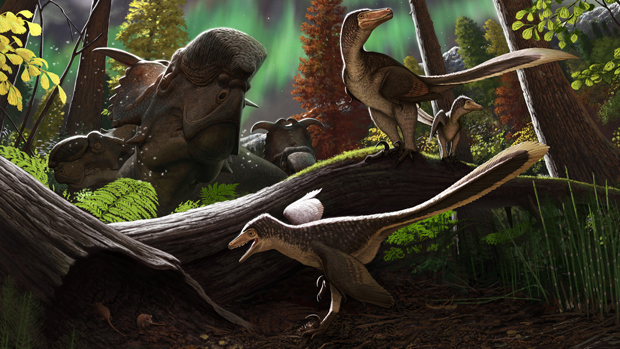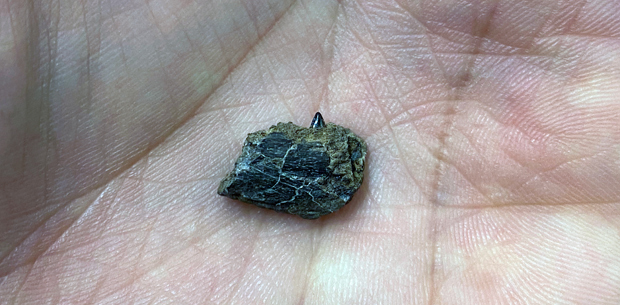The First Juvenile Dromaeosaurid from Alaska
This blog has covered a lot of news stories about dinosaur fossil discoveries from Alaska, principally the remarkable Prince Creek Formation with its abundance of juvenile hadrosaurid remains. A tiny partial lower jaw recovered from sediment screen washings indicates that dromaeosaurid dinosaurs were also present and from the size of the bone, complete with its two tiny teeth, it is likely that some dinosaurs were year-round residents and that they bred in the Arctic Circle.
A Flock of Dromaeosaurids Pursue Prey Under the Noses of Pachyrhinosaurs

Picture credit: Andrey Atuchin
A Juvenile Dromaeosaurid
Writing in the on-line academic journal PLOS One, researchers including Alfio Alessandro Chiarenza (Imperial College London) and Anthony R. Fiorillo (Southern Methodist University, Dallas Texas), report upon the discovery of the tiny jaw fragment that adds to a growing body of evidence that suggests Cretaceous Arctic dinosaurs of Alaska did not undergo long-distance migration, but rather they were year-round residents of these northern latitudes.
The fossil, which measures less than 1.5 cm in length, was collected from the Pediomys Point locality along the Colville River, some five miles (eight kilometres), upstream from the Liscomb bonebed with its abundant hadrosaurid remains. Field team members had collected a large amount of bulk sediment over several field seasons and the specimen (specimen number DMNH21183), was recovered after screen washing and sorting of material conducted back at the Perot Museum of Nature and Science (Texas).
The Tiny Fossil Specimen (Assigned to a Saurornitholestinae Dromaeosaurid)

Picture credit: A. A. Chiarenza
Anatomical features such as the fibrous bone surface coupled with the small size of the fossil suggest a juvenile.
Dinosaurs of the Far North
Commenting on the significance of the fossil find, Anthony Fiorillo stated:
“Years ago, when dinosaurs were first found in the far north, the idea challenged what we think we know about dinosaurs. For some time afterwards, there was a great debate as to whether or not those Arctic dinosaurs migrated or lived in the north year round. All of those arguments were somewhat speculative in nature. This study of a predatory dinosaur jaw from a baby provides the first physical proof that at least some dinosaurs not only lived in the far north, but they thrived there. One might even say our study shows that the ancient north was a great place to raise a family and now we have to figure out why.”
What Type of Dromaeosaurid?
At least four different subclades of dromaeosaurid are known from the Late Cretaceous of North America (Dromaeosaurinae, Microraptorinae, Saurornitholestinae, and Velociraptorinae). A phylogenetic assessment of the specimen suggests that this fossil represents a member of the Saurornitholestinae. This subfamily consists of two species of Saurornitholestes and Atrociraptor, between them these dromaeosaurs, although restricted to the Late Cretaceous, do have a widespread palaeo-geographical range, with fossils found as far north as Alberta (Canada) and as far south as New Mexico in the USA.
The scientific paper: “The first juvenile dromaeosaurid (Dinosauria: Theropoda) from Arctic Alaska” by Alfio Alessandro Chiarenza , Anthony R. Fiorillo, Ronald S. Tykoski, Paul J. McCarthy, Peter P. Flaig and Dori L. Contreras published in the academic journal PLOS One.
To read our recent blog article about the hadrosaurids associated with the Prince Creek Formation: Is this the demise of a duck-billed dinosaur?
The Everything Dinosaur website: Everything Dinosaur.






Leave A Comment